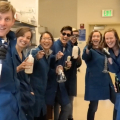The Evolutionary Origins of Light Sensitivity
The evolutionary origins of complex innovations like eyes are contentious and interesting because they involve multiple interacting components. Using phototransduction as a model, we are showing how investigating individual components of complex systems can elucidate their origins. Phototransduction underlies animal vision, utilizing numerous proteins to translate light information into nervous impulses. We are determining the components involved in phototransduction in the eyeless cnidarian Hydra magnipapillata and its relative with complex lens-eyes, the box jellyfish Tripedalia cystophora. We've found that Cnidaria are the only non-bilaterian animals with opsin-based phototransduction. Therefore, by determining how vision and phototransduction work in Cnidaria, we can make inferences about the very origins of phototransduction – and by extension eyes and vision – in all animals.
Our work has established that some key genes used in phototransduction of bilaterian animals, like flies, mollusks and vertebrates, are also used in cnidarian phototransduction. We test these hypotheses by integrating a variety of methods, including genomics, phylogenetics, confocal microscopy, behavioral assays, pharmacology, transgenics and RNA-interference.
Selected Publications
- Cnidocyte discharge is regulated by light and opsin-mediated phototransduction
- Blue-light-receptive cryptochrome is expressed in a sponge eye lacking neurons and opsin
- The evolution of phototransduction from an ancestral cyclic nucleotide gated pathway
- The origins of novel protein interactions during animal opsin evolution
- Key transitions during the evolution of animal phototransduction: novelty,“tree-thinking,” co-option, and co-duplication




